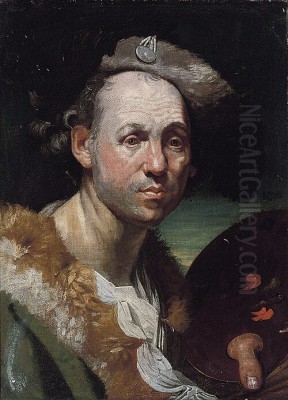
Johann Zoffany stands as a unique and perceptive figure in the landscape of eighteenth-century European art. Born in Germany, flourishing in England, and venturing as far as India, his life and work offer a fascinating window into the society, culture, and artistic tastes of the Georgian era. Renowned for his intricate "conversation pieces," theatrical scenes, and insightful portraits, Zoffany captured the nuances of aristocratic life, the drama of the stage, and the complexities of colonial encounters with remarkable detail and psychological acuity. His journey from a court artisan's son to a favoured painter of royalty and a founding member of London's prestigious Royal Academy is a testament to his talent, ambition, and adaptability.
Early Life and Continental Foundations
Johann Joseph Zoffany, or Zauffaly as his name was likely originally spelled, entered the world on March 13, 1733, in Frankfurt am Main. His father was a cabinet maker and architect associated with the court of Alexander Ferdinand, Prince of Thurn und Taxis. This courtly connection perhaps provided the young Zoffany with his first exposure to the world of art and patronage. Showing artistic promise early on, he initially studied in Germany, possibly in Regensburg under the local artist Martin Speer.
Seeking broader horizons and deeper artistic training, Zoffany, like many aspiring artists of his time, journeyed to Italy around 1750. He spent several years in Rome, immersing himself in the study of classical antiquity and the works of the Old Masters. While direct evidence of his teachers is scarce, he would have undoubtedly absorbed the prevailing artistic currents, including the burgeoning Neoclassical ideas championed by figures like Anton Raphael Mengs and the established Grand Manner portraiture exemplified by Pompeo Batoni. This Italian sojourn was crucial, refining his draughtsmanship and exposing him to the rich palette and compositional strategies that would inform his later work. His first marriage, reportedly an unhappy one, occurred during this period, perhaps contributing to his decision to seek fortune elsewhere.
Arrival and Ascent in London
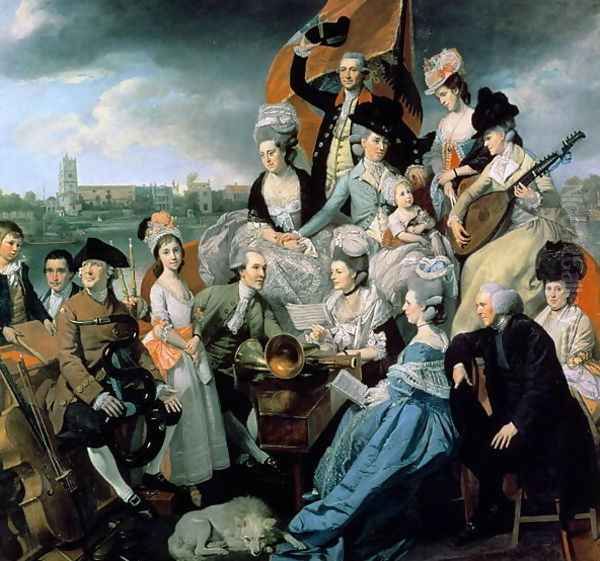
Around 1758 or shortly thereafter, Zoffany made the pivotal decision to move to London. England, particularly its capital, was becoming a vibrant centre for the arts, with a growing market for portraiture and genre scenes fueled by a prosperous aristocracy and merchant class. His initial years were not easy; tradition holds that he found early employment painting decorative motifs for clock faces for the renowned clockmaker Stephen Rimbault. A more significant connection was formed with the painter and mezzotint engraver Benjamin Wilson, for whom Zoffany worked as a drapery painter. This was a common practice, where established artists employed assistants to paint the costumes and backgrounds in their portraits.
Zoffany's breakthrough came through his association with the most celebrated actor of the age, David Garrick. Introduced perhaps via Wilson or through London's theatrical circles, Zoffany found in Garrick not just a subject but a powerful promoter. Garrick commissioned Zoffany to paint him in various theatrical roles, capturing the dynamism and emotional intensity of his performances. These paintings were novel, moving beyond static portraiture to depict actors in character within specific stage settings. They proved immensely popular, disseminated through engravings, and significantly raised Zoffany's profile.
Master of Theatrical Conversation
The paintings Zoffany created for David Garrick cemented his reputation as a master of the theatrical scene. Works like David Garrick as Abel Drugger in Ben Jonson's 'The Alchemist' (c. 1763-64) or David Garrick in 'The Farmer's Return' (1762) were groundbreaking. They offered audiences a vivid glimpse into the experience of live theatre, capturing specific moments, costumes, and stage designs. Zoffany's meticulous attention to detail, his ability to convey character through expression and gesture, and his skillful handling of lighting, often mimicking stage illumination, brought these scenes to life.
These theatrical works can be seen as a specialized form of the "conversation piece," a genre Zoffany would come to dominate. Unlike the often moralizing or satirical narrative scenes of William Hogarth, whose influence Zoffany certainly absorbed, Zoffany's theatrical pictures focused more on celebrating performance and personality. They documented a golden age of English theatre and provided invaluable records of acting styles and stagecraft. His success in this niche demonstrated his keen eye for narrative and his ability to manage complex group compositions effectively.
The Conversation Piece Perfected
While theatrical scenes brought him fame, Johann Zoffany truly excelled in the genre known as the conversation piece. This type of informal group portrait, showing families or friends engaged in genteel activities within domestic or garden settings, had gained popularity in Britain earlier in the century with artists like William Hogarth and Arthur Devis. Zoffany, however, elevated the genre to new heights of sophistication, detail, and psychological insight. His conversation pieces are characterized by their intricate detail, jewel-like colours, and the sense of relaxed, yet carefully composed, informality.

Works such as The Sharp Family (c. 1779-81), depicting the musical family on their barge on the River Thames, or The Family of Sir William Young (c. 1766) exemplify his mastery. Zoffany meticulously rendered the textures of fabrics, the gleam of polished wood, the specific features of his sitters, and the surrounding environment. More than just likenesses, these paintings explore familial relationships and social status. The arrangements often feel natural, yet they are carefully constructed to create a harmonious composition and subtly reveal the connections and interactions between the figures. Compared to the sometimes stiffer figures of Devis or the narrative drive of Hogarth, Zoffany offered a blend of realism, elegance, and quiet observation.
Royal Favour and the Academy
Zoffany's rising reputation soon attracted the attention of the highest circles in the land. He gained the patronage of King George III and Queen Charlotte, who were drawn to his less formal, more intimate style of portraiture compared to the grander pronouncements of court painters like Allan Ramsay or the increasingly celebrated Sir Joshua Reynolds. Queen Charlotte, in particular, became a significant patron. Zoffany painted several portraits of the royal family, often in relaxed, domestic settings that emphasized their familial virtues rather than solely their regal status.
A key early royal commission was Queen Charlotte with her Two Eldest Sons (George, Prince of Wales, and Frederick, later Duke of York), painted around 1764-65. This charming work, set within Buckingham House, depicted the Queen in fashionable attire, interacting affectionately with her young children. It marked a departure from the stiff formality often associated with royal portraiture and proved highly successful. Other works, like George, Prince of Wales, and Prince Frederick (c. 1765), continued this intimate approach. This royal favour culminated in Zoffany being nominated by George III as a founding member of the Royal Academy of Arts in 1768, alongside luminaries such as Reynolds, Thomas Gainsborough, Angelica Kauffman, Mary Moser, and Paul Sandby. This solidified his position within the British art establishment.
The Grand Tour and the Tribuna Commission
In 1772, Queen Charlotte sponsored Zoffany's return trip to Italy, specifically to Florence. The commission was ambitious: to paint a picture of the Tribuna room in the Uffizi Gallery, one of the most famous spaces in Europe, renowned for its collection of masterpieces of painting and classical sculpture. This project occupied Zoffany for several years (c. 1772-78). The resulting painting, The Tribuna of the Uffizi, is one of his most complex and celebrated works, a fascinating document of Grand Tour culture and artistic connoisseurship.
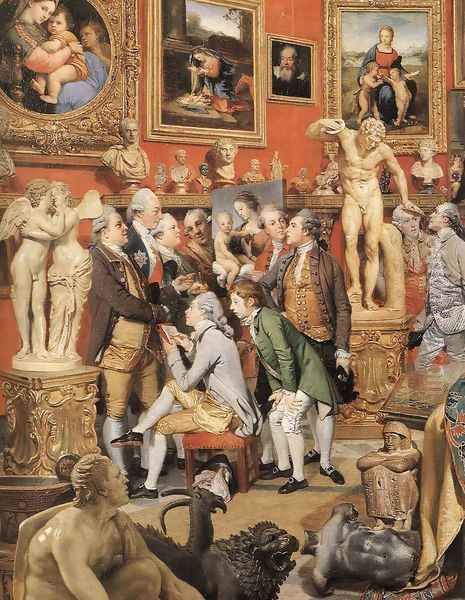
Instead of merely depicting the room and its contents, Zoffany populated it with a crowd of British and other European nobles, diplomats, artists, and connoisseurs residing in or visiting Florence at the time. They are shown admiring and discussing the artworks, which include famous pieces like Titian's Venus of Urbino and Raphael's Madonna della Seggiola, alongside classical sculptures such as the Venus de' Medici and the Wrestlers. Zoffany cleverly arranged these treasures, taking some liberties with their actual placement for compositional effect. He even included a self-portrait, showing himself looking out at the viewer. While a tour de force of detailed group portraiture and artistic homage, the painting did not entirely please the royal patrons upon its completion. George III reportedly felt Zoffany had spent too much time including portraits of various individuals rather than focusing solely on the gallery's treasures or securing portraits of the Austrian imperial family in Florence.
Adventures in India
Following the mixed reception of the Tribuna and perhaps seeking new opportunities and financial rewards, Zoffany embarked on a journey to India in 1783. This was a period of increasing British influence on the subcontinent, administered through the East India Company. India offered lucrative prospects for portrait painters catering to British officials, merchants, and military men, as well as occasionally to Indian rulers and elites. Zoffany spent about six years in India, primarily in Calcutta (Kolkata) and Lucknow.
During his time in India, Zoffany produced a remarkable body of work that captured the unique cultural encounters of the era. He painted portraits of prominent figures like the Governor-General Warren Hastings and the Nawab Wazir of Oudh, Asaf-ud-Daula. He also created lively genre scenes depicting the social life of the British expatriate community and their interactions with local culture. One of his most famous Indian works is Colonel Mordaunt's Cock Match (c. 1784-86), a vibrant, crowded scene set in Lucknow, depicting a cockfight attended by both Europeans (including Zoffany himself) and Indians, presided over by the Nawab. The painting is a fascinating, if complex, representation of colonial leisure and cross-cultural mingling. Other notable works include portraits of Indian nobles and scenes like The Embassy of Hyder Beg to Calcutta (c. 1787) and depictions of tiger hunts. He formed a friendship with Colonel Claude Martin, a significant figure in Lucknow known for his collections and patronage. Zoffany's Indian period was financially successful, allowing him to amass a considerable fortune, though his return journey to Europe in 1789 was marred by a dramatic shipwreck off the Andaman Islands, where the survivors reportedly resorted to cannibalism – an event Zoffany was rumoured, likely apocryphally, to have depicted. His work provided a valuable European perspective on India, distinct from artists who focused more purely on landscape, like Thomas Daniell and William Daniell, or earlier portraitists like Tilly Kettle and Ozias Humphry.
Return and Later Years
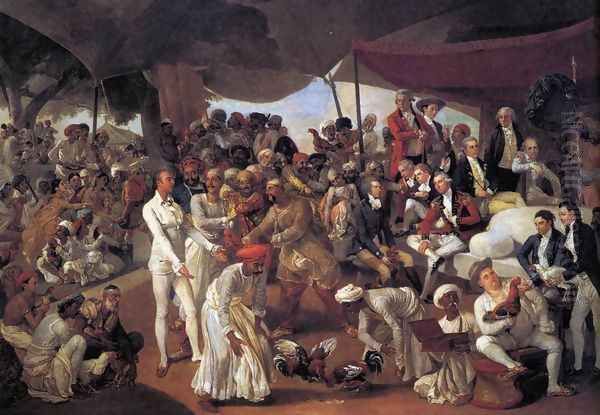
Johann Zoffany returned to England in 1789, a wealthy man thanks to his Indian ventures. He settled in Strand-on-the-Green, near Kew, west of London, and continued to paint, though perhaps his style, rooted in the detailed realism and Rococo elegance of the mid-century, seemed somewhat less fashionable in an era increasingly dominated by the broader handling of Reynolds and Gainsborough, or the emerging Neoclassical severity and the dramatic flair of younger artists like George Romney and Sir Thomas Lawrence.
Despite this, he remained a respected figure. He continued to exhibit occasionally at the Royal Academy. His later works included further portraits and some genre scenes, sometimes revisiting themes from earlier in his career. He painted The Farmer's Return, likely based on the earlier Garrick picture, around this time. His output slowed in his final years, possibly due to declining health. He lived comfortably in his Thames-side house, surrounded by the evidence of a long and remarkably varied career that had taken him from German courts to Italian academies, London theatres, English country houses, royal palaces, Florentine galleries, and the vibrant, complex world of British India. Johann Zoffany died at his home on November 11, 1810, and was buried in the churchyard of St Anne's Church, Kew.
Artistic Style and Technique
Johann Zoffany's style is distinctive for its blend of meticulous realism, clarity of colour, and compositional skill. Trained in the German Rococo tradition and refined by Italian study, he adapted readily to the tastes of the British market. His technique involved careful drawing, smooth application of paint, and an extraordinary ability to render textures – silk, velvet, lace, polished wood, metal – with convincing verisimilitude. His colours are often bright and clear, contributing to the lively, decorative quality of many of his works, particularly the conversation pieces.
His compositions, especially in group portraits and narrative scenes, are complex but lucid. He skillfully arranged figures to create a sense of natural interaction while maintaining overall balance and harmony. His lighting is often carefully observed, whether depicting the soft daylight of an English drawing-room or the dramatic illumination of a theatre stage. While capable of capturing excellent likenesses, his primary strength lay in depicting people within their environments, revealing character and social context through setting, costume, and interaction. He successfully fused the detailed observation associated with Northern European traditions with the elegance and compositional grace learned in Italy, creating a style perfectly suited to chronicling the nuances of Georgian society.
Legacy and Influence
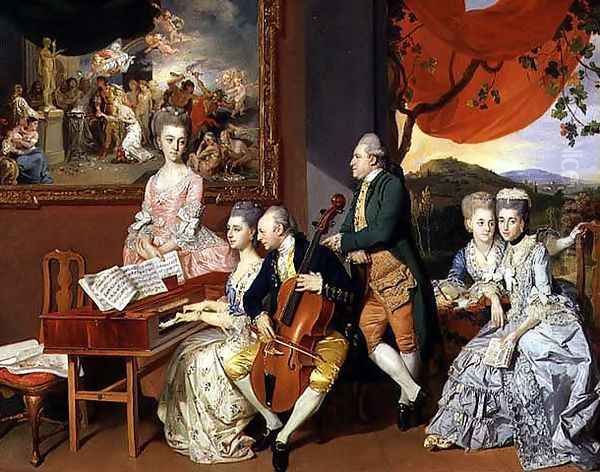
Johann Zoffany occupies a significant place in the history of British art. While perhaps not possessing the painterly bravura of Gainsborough or the theoretical ambition of Reynolds, he excelled in his chosen fields, particularly the conversation piece and the theatrical portrait. He brought a unique Continental polish and precision to these genres, elevating them beyond mere reportage to sophisticated works of art. His paintings provide an invaluable visual record of Georgian England – its domestic life, its leisure activities, its leading personalities, particularly in the theatre, and its burgeoning imperial reach in India.
His informal royal portraits helped shape a new image of the monarchy, emphasizing domesticity alongside dignity. His Tribuna remains a key document of Grand Tour collecting and connoisseurship. His Indian works offer a fascinating, if sometimes problematic, European perspective on colonial life and culture. Through his detailed, observant, and technically brilliant paintings, Zoffany captured the multifaceted world of the eighteenth century with a clarity and charm that continues to engage viewers today. He remains a crucial figure for understanding the art, society, and culture of the Georgian age, standing as a distinct and accomplished master alongside his more famous contemporaries. His work reminds us of the rich diversity of artistic practice in the period and the enduring power of art to document and interpret the human condition across different cultures and contexts.